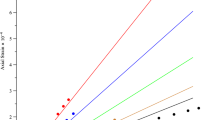Abstract
A new variational statement represented in the form of computational algorithm is proposed for elliptic systems of equations, which describe the behavior of structurally inhomogeneous geomedia under static loads. The inverse problem of boundary condition determination and calculated domain orientation from the point data of strain measurement is solved, which makes it possible to simulate adequately the stress-strain state of a rock mass.
Similar content being viewed by others
REFERENCES
W. Wittke, “Rock mechanics,” Springer-Verlag, Berlin, New York, London (1990).
L. A. Nazarova, L. A. Nazarov, and A. V. Leont'ev, “Three-dimensional model of the Tashtagol iron-ore deposit,” Fiz.-Tekh. Probl. Razrab. Polezn. Iskop., No. 3 (1998).
L. A. Nazarova, “Methodology of an adequate choice of input parameters for a 3-D geomechanical model. Geology and Computers,” in: Proceedings of the third international conference on advances of computer methods in geotechnical and geoenvironmental engineering, Moscow, Russia, 1–4 February, 2000, Yufin (ed.) A. A. Balkema, Rotterdam, Brookfield (2000).
S. L. Yunga, Methods and Results of Seismic Strain Study [in Russian], Nauka, Moscow (1990).
M. A. Sadovsky, L. G. Bolkhovitinov, V. F. Pisarenko, Deformation of Medium and Seismic Process, [in Russian], Nauka, Moscow (1987).
M. V. Kurlenya, V. N. Oparin, and A. A. Eremenko, “On relation between the linear dimensions of rock blocks and the fracture opening values in structural hierarchy of a rock mass,” Fiz.-Tekh. Probl. Razrab. Polezn. Iskop., No. 3 (1993).
E. V. Artyushkov, Physical Tectonics [in Russian], Nauka, Moscow (1993).
Ph. Siarlet, “Finite Element Method for Elliptic Problems,” North-Holland Publishing Company, Amsterdam-New-York (1978).
E. P. Shurina, O. P. Solonenko, and O. M. Klimenko, “Analysis of constructing the algorithms for simplicial grids when modeling the “drop-melt-base” interaction processes,” Preprint, Inst. of Theoretical and Applied Mechanics, Siberian Branch, Russian Academy of Sciences, No. 6, Novosibirsk (2000).
M. Yu. Balandin, O. V. Chernyshev, and E. P. Shurina, “LinPar: software for the solution of dense and sparse, symmetric and asymmetric systems of linear algebraic equations including ill-conditioned” in: Electronic publication, http://www.ict.nsc.ru//linpar
N. I. Muskhelishvili, Some of Basic Problems of Mathematical Elasticity Theory [in Russian], Nauka, Moscow (1966).
M. V. Kurlenya and V. N. Popov, Theoretical Foundations of Stress Determination in Rocks [in Russian], Nauka, Novosibirsk (1983).
I. A. Turchaninov, M. A. Iofis, and E. V. Kasparyan, Foundations of Rock Mechanics [in Russian], Nedra, Leningrad (1989).
N. S. Bakhvalov, Numerical Methods [in Russian], 1, Nauka, Moscow (1973).
A. Tarantola, Inverse Problem Theory, Elsevier, New York (1987).
L. A. Nazarova, “Estimating the stress and strain fields on the Earth's crust on the basis of seismotectonic data,” Fiz.-Tekh. Probl. Razrab. Polezn. Iskop., No. 1 (1999).
Rights and permissions
About this article
Cite this article
Nazarov, L.A., Nazarova, L.A. & Shurina, E.P. Determination of Strain and Stress Fields in a Rock Mass on the Basis of the Inverse Problem Solution. Journal of Mining Science 37, 38–45 (2001). https://doi.org/10.1023/A:1016728717773
Issue Date:
DOI: https://doi.org/10.1023/A:1016728717773




